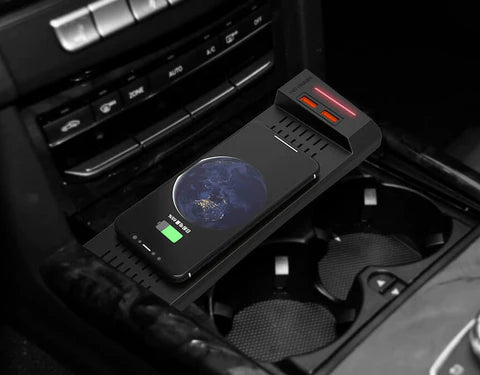Now the Mercedes-Benz E series in the market are equipped with wireless chargers, so why are there still modified wireless chargers on the market? After our research, let's see the reason.
What is wireless charging technology?
It is not difficult to understand the literal meaning, wireless charging is to transfer electricity without wires so that the power supply directly powers the electrical appliances. And this type of wireless charging can be roughly divided into two types - whether it needs to be in contact with the power supply. The wireless car chargers that we usually see in the car or the wireless chargers that come with the original car are all contact-type, that is, placing the mobile phone in a specific position to charge it. Compared with the former, the wireless charging method that does not need to be in contact with the power source can subvert people's travel and lifestyle. In the future, wireless chargers will change people's lives.

The concept of wireless charging technology can be traced back to the end of the 19th century, but in more than 100 years, wireless charging technology has developed far less rapidly than cars. It took more than 100 years from theory to initial civilization. However, even this "slowness" is still a small success now, which is closely related to the earliest wireless charging theory provider-Nicholas Tesla.
The charging principle used in the car wireless charger is also the most elementary magnetic field induction, but even this most elementary technology requires two hundred oceans. It is just a combination of a home wireless charging base, a mobile phone holder, and a car charger. Or we can call it "pseudo wireless charging".
Compared with the traditional car charger, it is more convenient, saving the steps of plugging and unplugging the cable in the car. Combined with the function of the mobile phone bracket, it is more convenient for the driver to charge the mobile phone and check the mobile phone in the middle (of course this is wrong), but it is still impossible to escape the power supply through the line. This is also the embarrassment of wireless charging technology at this stage - it still requires lines for power transmission.

When this technology came out, it was already engraved with a thankless label, but thanks to the WPC organization established by the City University of Hong Kong, which is the initiator of the "QI" wireless charging standard we know today. Its function is similar to the current national standard for electric vehicle charging. It aims to enable the electrical equipment of different electrical manufacturers to use each other, and the audience is quite wide. This is why I can talk about wireless charging with the car wireless charger purchased from the e-commerce company today.
The current wireless charging supports fast charging in addition to normal
Charging (5V 1.5A), but its rated output voltage and current for fast charging is only 9V 1.1A. It should be noted that the wireless charger has energy loss, that is to say, its input voltage and current will be larger, but the output cannot reach it. From the perspective of the composition of equipment of the car charger, there is energy loss when the original car 12V power supply is converted from the car charger, the line will lose some more (depending on the material of the transmission line), and the wireless charger will lose some more, which can be used for mobile phones. There is not much energy to provide charging.
Will the original wireless car charger with reduced transfer conversion steps be more efficient than the post-installed wireless car charger? Do the two have more advantages in charging efficiency than traditional car chargers? we did a test

In the normal charging mode, the charging capacity of the original car is much different from that of the external charger. Converted to the average output current, both belong to the level of the USB data transmission port. The charging speed of the original car is relatively slow by 30%. , the charging speed in fast charging mode is still a little gratifying, almost reaching the level of regular car charging.
The speed of the original car charger is a bit incomprehensible. The meaning of the charger's existence is to quickly charge our electronic devices. The original car wireless charger does not meet this demand. Maybe you put your mobile phone on the original car wireless charger for charging. Your mobile phone is not necessarily fully charged at night, so a series of modified wireless chargers have appeared on the market.
Whether you need to use a modified wireless charger depends on your personal needs. Some wireless chargers on the market are indeed a good choice. The appearance of these electronic products has indeed upgraded the interior of our car. We also believe that in the future "wireless chargers" "will revolve around our lives

